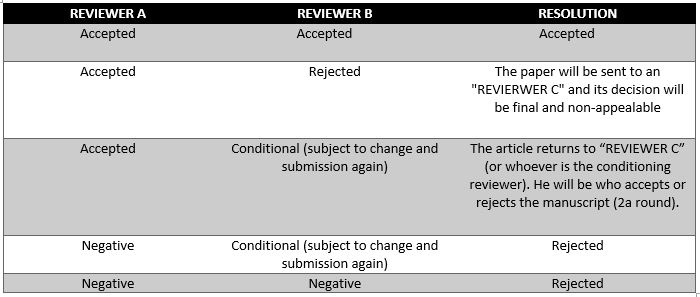Peer review process
Editorial review, anti-plagiarism and article evaluation
Lámpsakos takes approximately 90 days after receiving the manuscript for its publication, in case the verdict is positive. The times are distributed as follows: 10 days for preliminary editorial review (standards, topics and plagiarism). 35 days for the peer review process (including time for the search for reviewers), 10 days for author adjustments (according to peer suggestions), 35 days for the editing process (style review, layout, design approval and publication).
- Thematic review of structure and citation standards.
The pertinence of the text with the thematic axes of the journal and the fulfillment of the criteria described in the guidelines and the guide for authors is evaluated. If the article does not meet these parameters, it is returned to the author; if the formal or substantive presentation must be improved, the author is asked to make corrections and make a new submission within a time frame adjusted to the publishing schedule; if the article meets the aforementioned conditions, the second stage of the process will begin.
- Anti-plagiarism policy.
In order to identify whether the articles are original and unpublished and to avoid possible copies and plagiarism, professional technology is used to compare the manuscripts with others already published in different digital media, including the academic publications participating in Crossref. The technological system generates a report and similarity index; if the latter is higher than 25%, the article is discarded; on the contrary, if the index is up to 25%, the article continues in the third stage of the process. From the report, errors in the handling of citations and references, adequate use of primary sources and credibility of the information are identified in order to prevent plagiarism.
- Peer review.
The articles are submitted to peer review under the double-blind mode, i.e., the authors' information is confidential for the reviewers, and vice versa; in addition, neither personal data nor the evaluative concepts are disclosed among the latter. Once the evaluation of the article has begun, the authors undertake not to withdraw it until the end of the process. The estimated time between the reception of the article and its evaluation is three (3) months. This period may vary according to the subject matter of the article and other editorial processes.
- Selection of peer reviewers:the journal has a database of national and international academic researchers with experience in the field of engineering, supported by scientific publications. For each article, two peer reviewers are assigned who meet the following requirements:
i. master's degree and, as a priority, a doctorate;
ii. no conflict of interest with respect to the topic or article they are evaluating;
iii. not belong to the editorial or scientific committee of the journal or to the Universidad Católica Luis Amigó;
iv. if Colombian, must be recognized by Colciencias; otherwise, must have a graduate degree or an H5 index greater than 2.
- Review of articles:The journal's management delivers the article to the referees accompanied by Template review which the following formal and thematic elements are addressed:
i. Relevance of the article in accordance with the journal's interests.
ii. Correspondence of the title with the topic.
iii. Validity of the topic.
iv. Use of terms and concepts according to the discipline.
v. Relevance of graphs, tables and figures.
vi. Appropriate use of citations and references.
vii. Currency of references.
viii. Novelty of the work.
ix. Theoretical-methodological rigor.
x. Coherence of the text
- Decision: the format closes with three alternative opinions:
i. “It is published without modifications”;
ii. “Published with corrections”;
iii. “Not published”.
If both evaluators consider that the article "is not published", the journal's management communicates the decision to the author and sends, as support, the result of the evaluations delivered by the referees. If both evaluators agree that the article is "published without modifications", the author is informed of the decision and the article is sent to the editing stage. If one evaluator considers that the article should be published without modifications and the other that it should be published with corrections, the author is informed of the changes to be implemented and the date by which he/she should send the document with the requested corrections. If one of the two evaluations qualifies the text as "not publishable", while the other favors it, the journal's management will appoint a third referee (maintaining the "double-blind" modality) to settle the controversy. Once the third evaluation has been received, the author will be informed of the decision.




